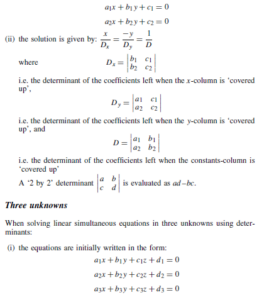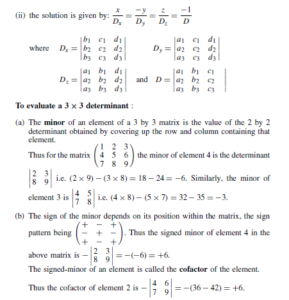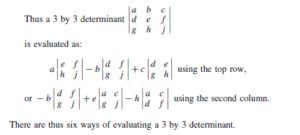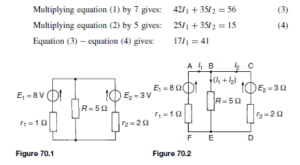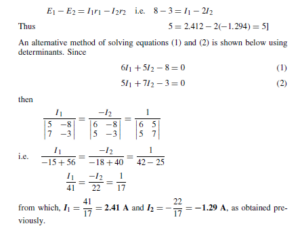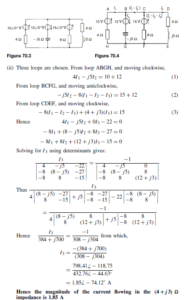Introduction
Voltage sources in series-parallel networks cause currents to flow in each branch of the circuit and corresponding volt-drops occur across the circuit components. A.c. circuit (or network) analysis involves the determination of the currents in the branches and/or the voltages across components.
The laws which determine the currents and voltage drops in a.c. networks are:
(a)![]() , where Z is the complex impedance and V the voltage across the impedance,
, where Z is the complex impedance and V the voltage across the impedance,
(b) the laws for impedances in series and parallel, i.e. total impedance, ![]() Zn for n impedances connected in series, and
Zn for n impedances connected in series, and ![]() for n impedances connected in parallel, and
for n impedances connected in parallel, and
(c) Kirchhoff’s laws, which may be stated as:
(i) ‘At any point in an electrical circuit the phasor sum of the currents flowing towards that junction is equal to the phasor sum of the currents flowing away from the junction’.
(ii) ‘In any closed loop in a network, the phasor sum of the voltage drops (i.e. the products of current and impedance) taken around the loop is equal to the phasor sum of the e.m.f.’s acting in that loop’.
In any circuit the currents and voltages at any point may be determined by applying Kirchhoff’s laws (as demonstrated in this chapter), or by extensions of Kirchhoff’s laws, called mesh-current analysis and nodal analysis (see chapter 71).
However, for more complicated circuits, a number of circuit theorems have been developed as alternatives to the use of Kirchhoff’s laws to solve problems involving both d.c. and a.c. electrical networks. These include:
(a) the superposition theorem (see chapter 72)
(b) The´venin’s theorem (see chapter 73)
(c) Norton’s theorem (see chapter 73),
(d) the maximum power transfer theorems (see chapter 75).
In addition to these theorems, and often used as a preliminary to using circuit theorems, star-delta (or T Ł :r) and delta-star (or :r Ł T) transformations provide a method for simplifying certain circuits (see chapter 74).
In a.c. circuit analysis involving Kirchhoff’s laws or circuit theorems, the use of complex numbers is essential.
Solution of Simultaneous Equations using Determinants
When Kirchhoff’s laws are applied to electrical circuits, simultaneous equations result which require solution. If two loops are involved, two simultaneous equations containing two unknowns need to be solved; if three loops are involved, three simultaneous equations containing three unknowns need to be solved and so on. The elimination and substitution methods of solving simultaneous equations may be used to solve such equations. However a more convenient method is to use determinants.
Two unknowns
When solving linear simultaneous equations in two unknowns using determinants:
(i) the equations are initially written in the form:
(c) The value of a 3 by 3 determinant is the sum of the products of the elements and their cofactors of any row or any column of the corresponding 3 by 3 matrix.
Network Analysis using Kirchhoff’s Laws
Kirchhoff’s laws may be applied to both d.c. and a.c. circuits. The laws are introduced in chapter 53 for d.c. circuits. To demonstrate the method of analysis, consider the d.c. network shown in Figure 70.1. If the current flowing in each branch is required, the following three-step procedure may be used:
(i) Label branch currents and their directions on the circuit diagram. The directions chosen are arbitrary but, as a starting-point, a useful guide is to assume that current flows from the positive terminals of the voltage sources. This is shown in Figure 70.2 where the three branch currents are expressed in terms of I1 and I2 only, since the current through resistance R, by Kirchhoff’s current law, is (I1 C I2 ).
(ii) Divide the circuit into loops — two in this ease (see Figure 70.2) and then apply Kirchhoff’s voltage law to each loop in turn. From loop ABEF, and moving in a clockwise direction (the choice of loop direction is arbitrary), E1 D I1r C (I1 C I2)R (note that the two voltage drops are positive since the loop direction is the same as the current directions involved in the volt drops). Hence
From loop BCDE in Figure 70.2, and moving in an anticlockwise direction, (note that the direction does not have to be the same as that used for the first loop),
(iii) Solve simultaneous equations (1) and (2) for I1 and I2
from which, current
The minus sign indicates that current I2 flows in the opposite direction to that shown in Figure 70.2.
The current flowing through resistance R is (I1 C I2) =2.412 + (-1.294) = 1.118 A = 1.12 A, correct to two decimal places.
[A third loop may be selected in Figure 70.2, (just as a check), moving clock- wise around the outside of the network. Then
The above procedure is shown for a simple d.c. circuit having two unknown values of current. The procedure however applies equally well to a.c. networks and/or to circuits where three unknown currents are involved.
For example, in the network shown in Figure 70.3, the magnitude of the current in the (4 C j3) Q impedance using Kirchhoff’s laws is determined as follows:
(i) Currents I1 , I2 and I3 with their directions are shown in Figure 70.4. The current in the (4 C j3) Q impedance is specified by one symbol only (i.e. I3), which means that the three equations formed need to be solved for only one unknown current.

